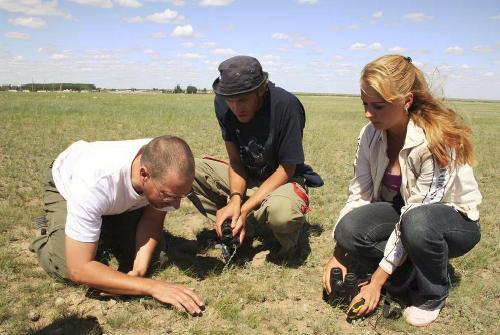Maxim Koshkin
The project will comprise various components to carry out extensive field research into the causes of the decline of the critically endangered Sociable Lapwing as a means to increase the conservation research infrastructure of Kazakhstan through the training of conservation scientists as they carry out this research.

The Sociable Lapwing Vanellus gregarius is a critically endangered species that has undergone a large population decline in recent years. Recent estimates suggest that the total breeding population is as low as 200-600 breeding pairs (AEWA 2004). The breeding population of Sociable Lapwing is believed to be concentrated in Kazakhstan with small populations in south-central Russia. The species is categorised as Critically Endangered according to the IUCN Red List (Birdlife International 2004) and Species Action Plan is issued. We’ve been undertaking detailed autecological work since 2005 in the Akmolinskaya oblast’ in central Kazakhstan east of Lake Tengiz.
Data have been collected on breeding distribution, nest survival, causes of nest loss, and chick survival. Breeding colonies appear to be concentrated around human settlements where short vegetation is present due to the presence of livestock grazing. A total of 252 nests have been located and monitored to date. In 2005 and 2006 respectively, 46 nests out of 85 (54%), and 93 nests out of 167 nests (55%), successfully hatched at least one chick. The main causes of nest loss differed between years with predation being the dominant cause in 2005 and trampling in 2006. Evidence from nest cameras suggests that sheep are the primary cause of trampling. Using an extension of the Mayfield method we calculated daily nest survival rates and used a GLM procedure incorporating a number of independent variables that may influence nest survival.
The variables included, amongst others, the distances to nearest settlement, nearest permanent water feature, and nearest predator perch. None of the measured variables had a significant effect on daily survival rates. Chicks were located, whenever possible, in the nest scrape and uniquely colour-ringed with a combination of four colour rings above the tibio-tarsal joint. Following colour-ringed chicks was found to be a more effective method of quantifying chick survival than radio-tracking. Chick survival was high with approximately one chick fledging per breeding female. This level of chick productivity exceeds that required by closely-related species, such as Northern Lapwing Vanellus vanellus to maintain population stability.
Working in field, professional researches from UK and Germany were sharing their experience with their Kazakhstani colleagues. During the field season of 2006 2 students from local Universities were intensively trained different field methods on data collecting, monitoring and data analysis. As the project continues the involvement of those trained students is planned, as well as training of new students this year.
Our results suggest that the demographic parameter driving the species’ population decline may not be associated with the breeding grounds, but could be attributable to factors on either the migration routes or the wintering grounds. Field work on both breeding grounds and migration routes will be continued to confirm these suggestions.